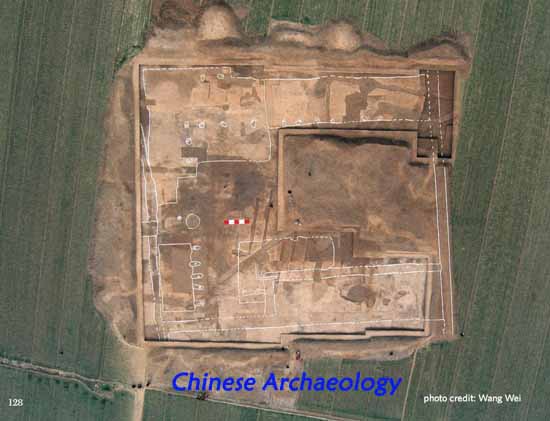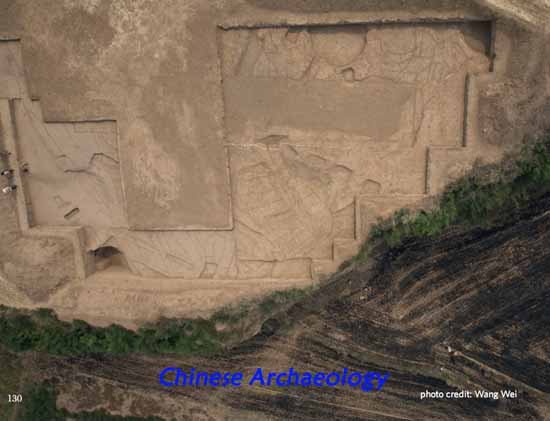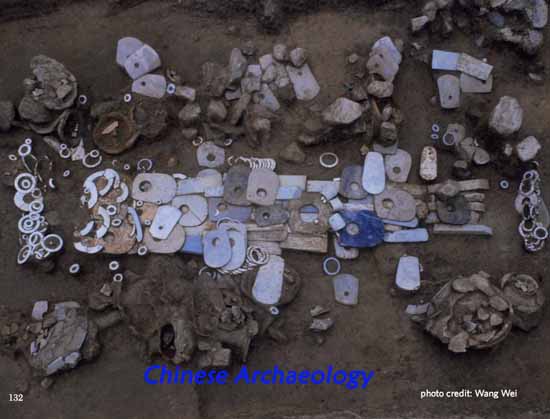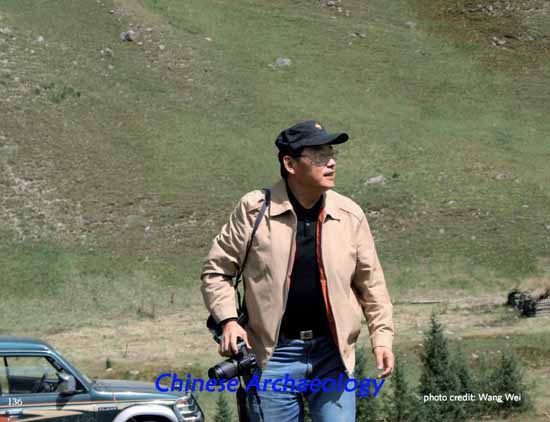In Search of the Origins of Chinese Civilization: a Long-term Transdisciplinary Program
Among the several primary civilizations that had a far-reaching impact of the development of humankind was that of early China. Since 2001, the multi-year project“In Search of the Origins of Chinese Civilization: a Long-term Transdisciplinary Program”has continued to receive the support of national research funding programs and has been in operation for twelve years, analyzing issues concerning the origins of Chinese civilization.

Research Objectives
A main objective of the research project is to increase the interdisciplinary collaboration between the social sciences, humanities and the natural sciences, with archaeology at its core. Archaeologists work in partnership with a wide range of specialists in radiocarbon dating, zoology, botany, metallurgy, GIS and many other disciplines in the natural sciences, approaching from multiple angles the fundamental research questions concerning the chronologies, locations, processes, and systems involved in the formation of Chinese civilization. Also central to the project is the comparative study of how Chinese civilization interacts with ancient civilizations nearby and afar, thereby clarifying the characteristics of Chinese civilization and its significance in the development of human civilization.
I. Cultural and social approaches
The cultural approach employs the techniques and research methods of the natural sciences in the investigation of how the material culture and spiritual life in various regions developed from 3500 BCE to 1500 BCE.
The social approach is based on the methods of settlement archaeology and focuses on the study of the cities of capital nature that best reflect important patterns in social development and changes in social structures. Understanding the layout of a settlement is a primary concern, especially the analyses of the location of the large-scale house foundations, high-ranking burials and remains that are associated with ceremonial activities. Excavations are planned according to these priorities. A main objective is to explore social organization and stratification through the study of, for instance, burial goods indicating status and ritual vessels. The process by which social, political, economic and religious authority is formed, the nature of these authorities and the systems through which they become consolidated over time are also key research questions that throw light on the issues of royal power and state formation.
II. Multi-dimensional reconstruction of ancient societies
1. While the emphasis is placed on the study of the upper echelons of society, extensive investigations are also made into the lives and organization of the lower social strata.
2. While the focus is on the study of cities of capital nature, research is also conducted on settlement clusters across different regions, as well as smaller towns and hamlets along the fringes. The goal is to analyze the interactions and exchanges between the center and the periphery.
III. The methods and techniques of the natural sciences are used to the establish the material foundation of Chinese civilization, through which the development of economies and production technologies, the interaction between groups of people and royal power over valuable resources are analyzed.
IV. Tracing the origins of the “determinants of civilization,” such as bronze vessels, textual inscriptions and cities, is insufficient. It is important to consider these determinants as the materialization of civilization and explore how they function in the formation and development of civilization.
V. Investigate the diverse processes toward civilization across different regions. Identify their characteristics and the rationale behind these processes, as well as analyze the rise and fall of groups that wield various kinds of authority in the societies in which they operate.

Research Components
I. The Emergence of Chinese Civilization and Its Early Development
1. The formation process towards civilization in different regions Explore how clan societies characterized by social equality transform into highly stratified societies with a powerful central authority (signaled by state formation). How do the trajectories of development towards civilization differ from each other across space and time? How can the particularities of each trajectory be explained?
2. The formation and transformation of the “multidimensional whole (duoyuan yiti)” of Chinese civilization How did the Central Plain assume such a critical position in the development of Chinese civilization? What are the interrelationships between the central region and the peripheral regions and how do their cultures bear upon each other? How did the various regional cultures and civilizations respond to the influence of the Central Plain Xia-Shang-Zhou civilizations? The research project identifies the many sources of origins of the Chinese civilization and examines the multiple ways different regional cultures and civilizations act upon, contradict and cooperate with each other over time.
3. The early phases in the formation of Chinese civilization Given the multidimensionality and plurality of the sources of Chinese civilization, how did it become a cohesive whole over time? What were the processes involved and how can they be characterized into distinctive phases? How does one phase relate to the other?
II. The Foundation, Cause, and Dynamics of the Formation of Early Chinese Civilization
1. The social, political, economic and religious systems in the formation of Chinese civilization.
2. The chronological phases of development.
III. The Meaning and its Evolution of Early Chinese Civilization.
The study of material, spiritual, and institutional spheres of early Chinese civilization, and their changes through time.
Material sphere: agriculture, husbandry, craft production, production technologies.
Spiritual sphere: worldview, perspectives on life and death, value system, religious beliefs, art.
Institutional sphere: kingly authority, state, systems of management, political apparatuses, social hierarchy

Research Outcomes
Over the past twelve years, research results have been produced through the collaborative efforts of specialists in different disciplines. The highlights of the accomplishments are as follows:
1. Chronologies of the various regional cultures and settlements dated to 3500-1500 BCE have been established with radiocarbon data, stratigraphic data and through other scientific methods.
2. The conditions of and changes in different regional natural environments between 3500-1500 BCE have been systematically investigated and the basic contours of their relationships with the developmental trajectories of regional civilizations have outlined.
3. The impact of the advances in agriculture and craft production between 3500-1500 BCE on the economy of different cultures and their control over resources has been analyzed.
4. The excavations of settlement clusters and habitation remains in the surrounding areas have shed new light on settlement patterns, social organization, social stratification, and the emergence and strengthening of authorities at the local and regional level and other related issues.
5. Interpretations of excavated archaeological materials have enhanced our general understanding of developments in agricultural and craft production, craft specialization, elite control over prestige goods and rare resources; population growth, movement and concentration, and the related emergence of capital cities; social stratification and the emergence of a central authority in control of military affairs, ritual activities and other political, economic and social aspects. In archaeology, early state formation is evidenced in: advances in agricultural and craft production; monumental buildings and public facilities that require the mobilization of massive labor resources; palaces and temples that represent and augment royal power; high quality and finely crafted material objects that indicate and enhance the owner’s status found in high-ranking and large burials and other contexts.
6. General understanding of the formation phases and processes of early Chinese civilization
(1) The earliest signs of social differentiation emerging from changes in the organization of production can be detected six thousand years ago in the Central Plain, Middle and Lower Yangzi River region and other areas. The formation of civilization hereafter gained momentum.
(2) Abundant jade artifacts, high ranking and large burials, and monumental structures for ceremonial activities have been excavated in Niuheliang in Liaoning, Lingjiatan in Anhui and Dongshancun in Zhangjiajiang, sites dated to around 5000 BP. Evidently, five thousand years ago, social stratification had already been deeply entrenched in some areas. By exercising a monopoly over ritual activities, the elites secured their control over the society. Embryonic forms of “royal authority” may have been in place. Civilization had likely been formed around this period of time, validating the notion of “five thousand years of civilization” in China.
(3) Excavations uncovered large-scale cities, palace foundations, large burials in Liangzhu, Taosi and other sites dated to around 2500 BCE, providing evidence that prior to the Xia dynasty, state formation occurred in the areas where cultural and social developments were more advanced, and early states or archaic states had emerged.
(4) Civilizations of a dynastic nature began to take form during the later phases of the Xia dynasty at the site of Erlitou, where an urban road network, a monumental palace complex with a clear axis, bronze and jade ritual vessels, and government-run bronze and turquoise workshop have been excavated.
7. Extensive analyses of interactions between various regional cultures, the mechanisms that gave rise to Chinese civilization and generated changes in its development into a multidimensional whole have been conducted.
Wang Wei (Institute of Archaeology at the Chinese Academy of Social Sciences)
Zhao Hui (Peking University)

Biographical Sketch
Wang Wei, the Director of the Institute of Archaeology, CASS, received his BA in Archaeology (1982) from Jilin University. He obtained his Ph.D. degrees from Kyushu University in 1995 and the IA, CASS in 1996. At CASS, he continues to be fully committed to research activities and supervision of doctoral students. Dr. Wang is an academician at the Chinese Academy of Social Sciences; he is also a foreign honorary member of the Archaeological Institute of America, and corresponding member of the German Archaeological Institute. Currently Dr. Wang is vice president of the Archaeological Society of China. Professor Wang Wei directed the excavations of the palace precinct at the Yanshi site in Henan, in 1996-1998, the Western Zhou palace foundation at Zhouyuan, Shaanxi, in 2000, and the Xiaomintun site, Anyang, in 2003-2004. His major research interests include Xia-Shang-Zhou archaeology and the formations of East Asian civilizations and the interactions between them. In recent years, he has directed several national projects, including “In Search of the Origins of Chinese Civilization: a Long-term Transdisciplinary Program”, “The Origins and Early Development of Chinese Civilization”, and “Origins of the Mongols and Yuan Dynasty Imperial Tombs.”

